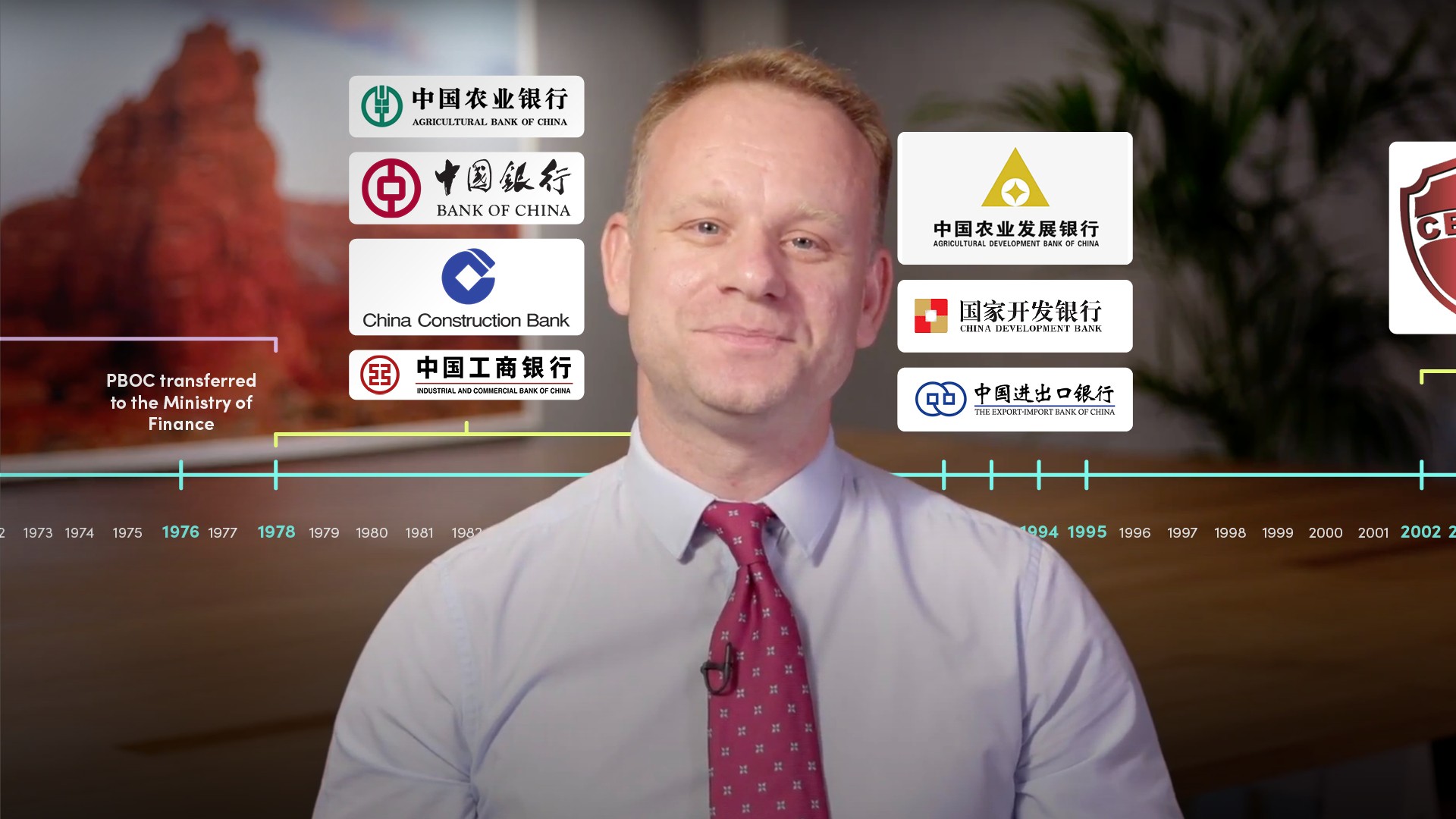
Introduction to China's Banking Industry

Iain Hoggarth
15 years: Risk & compliance
China has become a leader in financial services in the past 70 years. Iain discusses how the country has reached this point by explaining the development of the country’s modern banking system.
China has become a leader in financial services in the past 70 years. Iain discusses how the country has reached this point by explaining the development of the country’s modern banking system.
Subscribe to watch
Access this and all of the content on our platform by signing up for a 7-day free trial.

Introduction to China's Banking Industry
9 mins 51 secs
Key learning objectives:
Understand the origins of China’s banking industry
Follow the modernisation initiatives that China has worked implement
Overview:
China’s banking history has seen ample change due to shifts in culture and revolutions. This has led to several different sub-eras of China’s banking landscape to emerge, which have all shaped how the system functions today.
Subscribe to watch
Access this and all of the content on our platform by signing up for a 7-day free trial.
To what extent did China adopt the western model of banking?
From the end of the Qing dynasty, China went through various political and economic changes. These changes affected all levels of society and are still being felt in today’s China. The first western style Chinese banking institution to establish in China was the Imperial Bank of China in 1897. The main responsibility of the bank was debt issuance and money issuance in the empire. Since the western model of banking was considered a success in this guise, leading up to the XinHai nationalist revolution in 1911 and the overthrow of the royal household, the incumbent government had already set up 7 such western style banks in China. Including foreign banks operating in China at the time, this brought the total Western and Western Style Banking institutions in China to around 45 in 1911, with assets exceeding 200m Yuan.
How did war and revolution impact China's banking regime?
Following the XinHai revolution, overthrowing 250 years of imperial rule, the industry was majorly impacted by the republican movement. 9 years later, in 1920, the number of Chinese owned banks had increased to 103, to 158 by 1925, topping at 164 in 1937, with the onset of hostilities. By this time assets exceeded 400m Yuan and this growth actually had the effect to reduce the performance and influence of the foreign banks of the colonial and western powers.
During these developments, due to issues such as the currency reissue between 1933 and 1935 in addition to the Nationalist government’s struggle to control currency flows from traded goods and taxes, it took some time for the industry to come under the full control of the Nationalist authorities and attain stability.
Due to the two ongoing conflicts, from 1937 to the declaration of the People’s Republic of China in 1949, the industry entered a period of consolidation and uncertainty, and few constructive developments occurred at this time.
In 1948, prior to the communist victory, the PRC faction had already begun consolidating the industry in establishing the People’s Bank of China. This banking institution would consolidate the industry under one name and was to last in this form for 30 years until 1978. In this 30-year period, the PBOC was to make a lasting contribution to China’s development.
How did the events between 1949 - 1978 impact the People’s Bank of China?
From 1949 - 1965, PBOC maintained an integrated and standardised banking system to promote economic rebuilding and provide basic functions of cash and debt issuance. One challenge after liberation was also to continue to support the war that was continuing on China’s western frontier. The bank continued to handle regular banking business for the republic, including state capital management, remittance and foreign exchange.
From 1966 - 1976, following the subsequent problems associated with the cultural revolution, the bank suffered further losses to it’s credit base and a further weakening of the banking structure occurred, as economic authorities in the government attempted to maintain economic output, whilst dealing with the disruption of the cultural movement. At the end of the period, the bank was transferred to the ministry of finance – a start of a move towards market economics and prudent economic management.
Between 1976 - 1978 and following the conclusion of the gang of four incident, where rising liberal economic proponents reemerged in the annals of power, the banking system resumed ordinary activities, and the state council had begun to take measures to break the integration of banking functions established 30 years prior under the 大一统 system. In 1977, the state council made the first decision to break up the centralised nature of banking; the first steps towards major change at the PBOC.
What modernisation initiatives did China implement during the era of economic openness?
- 1978 – 1986: the state council allowed four state owned banks to be formed to handle commercial financing affairs in the new era of economic openness. These banks would handle economic growth generated by the rising international trade of the era
- 1986-1992: industry growth further increased in the period alongside rapid economic growth, and it is noted that between 1978 and 1992, China’s depositor base increased 19 fold and the lending base 13 fold in the period
- 1992-2001: this period was one of further great change and growth and included major legislative changes
- 1993: state owned enterprises were permitted to operate new regional commercial banking institutions
- 1994: China created policy banks to handle centrally planned economic growth. Previously this was handled within the four major state owned commercial institutions. This created The Import Export Bank of China, China Development Bank and the China Agricultural Development Bank
- 1995: saw issuance of major new laws to better define the role of the central bank and that of the commercial institutions
In what ways did China reform its banking system between 2002 - 2018?
The 2002-2018 period saw China’s banking system’s greatest period of market modernisation. This period saw:
- Greater reforms of product offerings
- Listing of domestic banks on foreign markets
- Strengthening of regulatory standards to create a globally competitive industry
- Support for smaller local institutions
The period also saw the greatest liberalisation and growth of related insurance, fund and asset management industries and also the permitting of foreign institutions to handle local RMB currency.
The PBOC would continue its role as central bank and monetary authority but lessen its regulatory responsibilities.
At this time the role of SAFE, the State Administration of Foreign Exchange, also increased its influence, particularly with the need to prudently handle China’s increasing holdings of foreign currency and debts.
China also made positive moves in financial crime regulation, with the creation of the China Anti Money Laundering Monitoring and Analysis Centre, (CAMLMAC), in 2006. By August 2018, total banking assets reached 255 trillion yuan, reflecting annual growth of 6.9% and borrowings totally 235 trillion yuan, with similar growth at 6.4%.
Subscribe to watch
Access this and all of the content on our platform by signing up for a 7-day free trial.

Iain Hoggarth
There are no available Videos from "Iain Hoggarth"



























